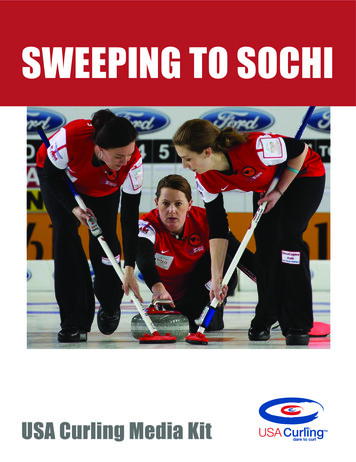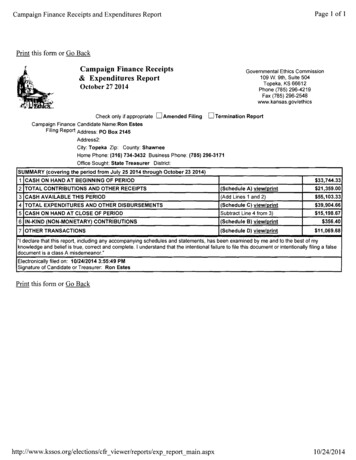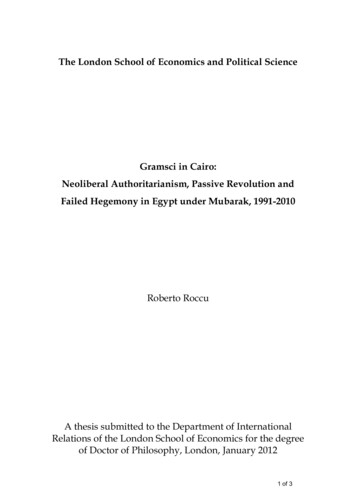
Transcription
Newsletter of the London Curling ClubDecember 2014Music teacher in tune with curling tradition lauds SiftonBill Courtney knows bonspiels – lots of them. High on his list of his favourites is the Harry Sifton Classic, although he hasn’tcompeted regularly at the LCC event since moving from Windsor to Wasaga Beach. The winter commute from there can beperilous.“They had a dinner where you wore a tie and a blazer – no jeans. There was an open bar for an hour,” he says of the Siftonevent. “They know how to hold it. Prior to the dinner, a bunch of us would get together at the London Curling Club and wewould jam. We had a group of good singers. They would entertain. It was sing-along stuff. I had quite a wide scope in music. Iknow the old Irish and Scottish songs.”Courtney knows a lot about curling and music, which came together nicely for him during a five-year stint with the air force.From 1962 until it was closed in 1967, he was a full-time music teacher to officers’ children at Centralia, which was one ofmany bases across Canada in the British Commonwealth Air Training Plan that instructed Second World War air crew. It wasa job that opened the door for him to bonspiels around SouthwesternOntario. He was an eager participant.Perhaps foreseeing the day when the base would close, its schoolprincipal told the teachers if they had the least inkling of landinganother job to take a day off to explore it. Courtney saw this as anopportunity to enter many area bonspiels. The base had its own foursheet curling rink in a Quonset hut so there were potential teammates.One of his recruits was a flight lieutenant who was the head officer onthe base. “He was not much of a curler but he had a driver (whoserved as their designated driver). We made up this team. We went tobonspiels almost every Wednesday. We were winning our share andWinners of the two-day Sifton Classic traditionallydrinking our share,” Courtney quips.receive their trophy a year later at the first-nightThe air force approved because its travelling curlers were doing a goodbanquet. This is because the champions are notjob of public relations at clubs all over the area, including the LCC. Hedecided until the next morning.The 2013looks back affectionately at his Centralia days, living with his growingchampions from Highland are, from left, Dougfamily in the PMQs (permanent married quarters) on the base withinGlass, Don Lahti, Steve Gray and Dick Bowman.walking distance of the curling club, where a beer cost 25 cents andmixed drinks were just 10 cents more. When the senior officer left in the evening they closed the club door.After the base was shut down Courtney’s teaching experience helped him land a secondary school job in Windsor, teachingmusic. He joined the Windsor Curling Club and got an instant awakening to the reality of civilian life. After paying just 25 ayear in curling membership fees for his whole family at Centralia, his first year at the Windsor club cost him 725.When a tornado destroyed the Windsor Curling Club in 1974, killing eight people (a ninth curler died less than a year laterfrom injuries), Courtney helped organize that city’s Roseland Golf and Curling Club that opened to fill the void. “They werestarting a curling club and had tons of people who didn’t know anything about curling.”Like Courtney, city of Windsor controller Ed Agnew was a musician. He was on the board to get Roseland started and hecalled on Courtney to “show these people there’s more to curling than just what goes on out on the ice.”He could not have asked a better person to introduce new curlers to the social side of the game. Long-time London curlerJack Judd remembers Courtney as “a guy with a real sense of humour.” Other Sifton regulars will recall Courtney for themusic he provided at the piano keyboard and with his auto harp, as well as his outgoing personality.On some bonspiel entry forms he has been known to list his home club as the Wasaga Beach Curling Club, which doesn’texist. He curls out of nearby Stayner. When someone would ask him how things were going at the Wasaga Beach club, hewould reply, “I haven’t been out there yet. The lake hasn’t frozen over.”Burt DowsettPage 2President’sColumnPage 3Fay tirelessvolunteerPage 4SiftonresultsPage 5WDSreport
ROCK TALK – December 2014Page 2Redesigned LCC website offers new format, extrasAs many of you have noticed by now, the LCC has a redesigned website. The new designoffers all the same things as the old one in a new format, plus several extras such as access tothe club roster after registering online. Go to the site http://www.londoncurling.ca and check itout. The LCC is in great debt to Eric Duggan, who has single-handedly accomplished this task.Thank you Eric!When I first came to this position I had no idea how complex the creation of a good curling icesurface is. Obviously, the first step is a modern ice plant. At the LCC our ice plant is 10 yearsold and is maintained by Drennan Refrigeration and our head ice technician, Kevin Breivik.The ice plant consists of essentially two sections. The refrigeration plant works like a giantfridge and the brine (a concentrated solution of calcium chloride) is circulated through therefrigeration section and then pumped out through the headers under the ice surface and thenback again through the refrigeration plant. This past month the motor that drives the brinepump and then the pump itself had to be shut down to have their bearings serviced. It was anormal wear-and-tear event. The headers had to be replaced a year ago, which was considerably earlier than expected. Noone could explain why they deteriorated so early but we replaced them with stainless steel, which should give us manyyears of service.The second section is the environment that you are creating the ice in. In our case it is a very old arena. Although it hasbeen well maintained over the years it is poorly insulated. This means the ice plant has to work overtime in warm weatherand in extreme cold the ice surface is colder than desired, which greatly affects the curling surface and obviously is muchmore uncomfortable for curlers. The solution to this is a better insulated arena, which at the moment is beyond our reach.The final stage in a good ice surface is the ice maker and the ice technicians. They are responsible for the cleaning,scraping and sculpting the ice. Ice is constantly changing. It evaporates, sublimates, wears down and builds up. Several ofthese issues depend on the arena itself so it is difficult to maintain the ice exactly as we would like in our building. But inspite of that the ice makers scrape the surface on a daily basis, trying to maintain the best surface possible. After scrapingthe surface, it is cleaned, pebbled and nipped before each draw. The pebbling is also critical. Too much, too little, too warm,too cold all affect the ice surface. So the next time you’re in the hack think of all that is involved.On behalf of the Board of Directors and the entire staff of the LCC, I want to wish everyone a Merry Christmas and a safeand prosperous New Year.John Crosby, LCC PresidentOntario Curling Report plays ‘final end’ of its 40-year runUnder the headline “Our final end,” editor Bob Weeks wrote the obituary for the Ontario Curling Report, which had coveredour sport for more than 40 years. “The simple reason is money. There simply isn't the financial support for a curlingnewspaper any more as the world turns digital. People get their news now from places like curlingzone.com and can readscores and results via Twitter, often directly from the players themselves,” wrote Weeks.He went on to outline some of the paper’s accomplishments, from “getting Labatt's to return to the Purple Heart, to gettingthe free-guard zone implemented and to punting a number of officials who simply had to go. Last year, we finally gotanswers to the ‘member not in good standing’ debacle the CCA put the OCA into and helped change the course of theOCA's leadership. I don't want to take full credit for all of these things; just that we helped move the needle and providedmuch-needed information.”Weeks added that the OCR “didn't always make friends with people in high places . . . but we were always happier to servethe curlers first.”18472014LONDON CURLING CLUB377 Lyle StreetLondon, Ontario N5W 3RSTelephone (519) 432-3882Email: Info@londoncurling.caWebsite: http://londoncurling.caBOARD OF DIRECTORSEXECUTIVE COMMITTEEPresidentVice PresidentPast PresidentTreasurerSecretaryProperty Maint./PlanningJohn CrosbyPaul PergauGord SelleryDave PeelingFay WeilerDave WeberPORTFOLIO DIRECTORSAdvertisingLeagues & OCAPromotionMember ServicesSkills & DevelopmentPro ShoppeDon AgnewBruce ThomMarjorie DudleyRoger MoyerPat BootheRichard RodgersCLUB STAFFClub ManagerDoug PetchInfo@londoncurling.caWEBSITEEric ing.caOffice ManagerHead Ice TechnicianIce AssistantsROCK TALKBar CoordinatorBar StaffHousekeeperBarb ColbournKevin BreivikMark PhillipsScott BreivikDerek ShadlockJason LaroqueStan SmithBruce ThomLes SonierBillie CampbellKatie McNaughtKim ElsdonBurt Dowsett(519) 641-4948rocktalk@londoncurling.caburt dowsett@yahoo.caIssue DeadlinesOctober 27November 24December 18January 26February 23
ROCK TALK – December 2014Page 3In gymnastics or curling, Fay Weiler makes an impactFay Weiler saw the writing on the wall for her career as a competitive gymnast. “Theychanged the rules drastically and I was just too old. They wanted the jumpy little ones,”she said of the rise to the podium of early-teens girl gymnasts. “They were doing verydifficult things.” At age 20, her competitive career was over.But anyone who has been around the London Curling Club knows Fay is a take-charge,tireless volunteer and should not be surprised at her next steps in gymnastics. First camecoaching, but that was complicated by the fact that her husband, fellow LCC memberWillie Weiler, was in the Canadian army and was transferred every four years. “You’dwork a kid up to a level and then you’d move. It takes a long time to get a gymnast up tothe level where they are competing. In those days there weren’t a lot of coaches and youknew they would have no one to coach them. That’s when I went into judging.”Fay found judging a better fit for their military lifestyle and she pursued it right up to thepinnacle of three Olympic Games – Mexico (1968), Munich (1972) and Montreal (1976).She was supposed to go to Moscow in 1980 but Canada withdrew. Willie was also deeplyinto gymnastics as a five-time Canadian men’s champion and Olympics participant as aFAY WEILERcompetitor, coach and judge.Fay jokes that one of the things that pushed her to advance to the top ranks of judging was “to stop being called Willie’swife. I have a name.” She started judging in 1960 and judged until 2004.“I was the first internationally qualified Canadian judge for women. During that time until I retired, I was Canada’s chiefjudge for women. That entailed directing all the judging at every national and international competition within Canada. I alsodrew up and ran the judges’ training courses at the national level and I judged a lot of international meets (including thethree Olympics).”She also served on national committees for various groups, including the Commonwealth Games, the Pacific Alliance andthe Pan-Americans. Weiler also served on the women’s gymnastics technical committee, as well as being Canada’srepresentative to the international committee for gymnastics. She was responsible for training Canada’s judges andpreparing them to get their international status.“Many of those committees had a political aspect to them,” said Fay. “With the political stuff the international federation triedto stop it by assessing your scores against their own. If you were too far off you would get a reprimand or not be allowed tojudge again.”Fay’s work in gymnastics did not go unnoticed. She was the first winner of an Investors Group award for officials and sportadministrators. Also, there was a judging award named after her, the Fay Weiler Award for Judges.When Willie was transferred to London in 1981 the Weilers joined the LCC, at the urging of Fay’s sister, Joan Cuthbert (stilla member) and her husband, Bill. “When we started curling it was for an activity and the social aspect. I did not want to addany new stress. I decided I would never be skip, or be on a competitive team and never do bonspiels.”But her extensive volunteer work with gymnastics made for a natural transition to similar work at the LCC. Knowing howcrucial volunteers are in gymnastics, she took on the same challenge with the LCC. She started volunteering with thewomen’s program, rising to women’s chair and then graduating to the board level. She is currently the board secretary, is aformer club president and served in various portfolios, including the “curling committee” (now known as “leagues andOCA”). She has served as drawmasters for bonspiels, worked on club fund-raising, volunteer recognition, the calendar,registration . . . “all that administrative stuff.”She certainly made her own name in both gymnastics and at the LCC. No longer do people refer to her as “Willie’s wife.”Burt DowsettEditor’s note: This is the third in a series of profiles of LCC members.
ROCK TALK – December 2014Page 4Highland rink wins second successive Sifton ClassicWhen the final rock came to rest at the 31st Harry Sifton Classic this month, the result was a mirror image of last year. TheHighland rink of Doug Glass, Don Lahti, Steve Gray and Dick Bowman had finished first again.Playing in A flight, the champions accumulated 52 points, while the LCC’s Bob Kerwin and Tillsonburg’s Dave Irelandfinished second and third in that flight with 38½ and 38 points respectively.Another Highland rink skipped by Doug Nixon finished second overall and first in B flight with 46½ points. LCC’s Dave Rushwas second in B flight with 44¼ points, while Chuck Townsend’s LCC rink was third with 39¾ points.Al Prentice, whose roots with our club go back to 1958, remembers when interest was so high in the Sifton Classic thatLCC teams had a playoff to determine which eight rinks would gain entry. Some years the event had 32 teams but it hasfallen off in recent years. This year there were 20 teams, of which nine were from the host club.Sifton convenor Gord Sellery hopes to reverse that trend. The first line of recruitment had been to send a letter to all clubmanagers and presidents, from Leamington and Kingsvillle in the west to Brantford, Norwich and Woodstock in the east.The north and south parameters were from Exeter to St. Thomas and Tillsonburg in the south. This encompasses 21 clubs.“This year, I gave entry forms to our members going to bonspiels at other clubs. I am going to write to specific senior menwho have convened bonspiels that have circulated their entry forms to our club. Also, I may . . . call the managers to makesure the bonspiel is publicized in the club rather than just filing the entry form.”A flight third place: Dave Ireland, EdMuth, Dave Peeling (LCC spare),Gerald Sandham, of TillsonburgA flight second: Bob Kerwin, TerryCrawford, Richard Rodgers, BobWakefield of LCCA flight & overall first: Doug Glass, DonLahti, Dick Bowman, Steve Gray ofHighlandB flight third: Chuck Townsend, KenWalmsley, Ralph Lutes, BarryMontgomery of LCCB flight second: Dave Rush, Rob Dann,John Rudell, Kevin MacDonald of LCCB flight first: Doug Nixon, Bill Heasman,Leigh Folliott, Tom Geldard of Highland
ROCK TALK – December 2014Page 5Card party, Jeanettes bonspiel kick off WDS seasonSeventy-one women playing a variety of games attended the first WDS card party of the season on Oct. 29. Several formermembers and curling friends attended, as well as many out-of-club women.The card party committee served sandwiches, veggies and desserts donated by WDS members, providing an atmosphereof fun and friendship. We thank all who donated food, time and prizes and also convenor Jean Walmsley and co-convenorJoan Bancroft. A profit of 544 will be used to defray WDS expenses during the season. The next card party to beconvened by Karen Lowry will be held on Jan. 28.The LCC was all “atwitter” on Nov. 5 as the WDS played host to itsannual Jeanettes Early Bird Bonspiel, one of the first events of theseason. Teams from four area curling clubs – Aylmer, Ilderton,Chatham and Highland, as well as seven in-club teams, participated.Ornamental birds, nests, eggs and birdhouses decorated the club. Thespecial bird this year was that quintessential early bird – the NorthAmerican robin.This event has been sponsored for 12 years by Joyce Hetherington tohonour a four-generation family tradition of many of the girls having“Jeanette” as one of their names. Unfortunately, Joyce had animportant event that day and was not able to attend. The first-placeteam from Aylmer included Jeanette Pesall, Bozena Boadway, BerthaStrickland and Roberta Wilson. How appropriate that a “Jeanette”placed first! Second-place winners from Ilderton were Judy Oryniak,The Aylmer rink of Jeanette Pesall, BozenaWendy Young, Gail McMahon and Becky Ostrom. The third-placeBoadway, Bertha Strickland and Robertateam was skipped by the LCC’s Jean Walmsley, with Shirley Vaile,Wilson won the Jeanettes Early Bird Bonspiel.Marianne La Rose and Donna Millar. Fourth place went to LindaBailey’s LCC team of Carolyn Sheppard, Kathie Leigh and Joan Crosby. Gift certificates for the Pro Shoppe were given as“Blue-Footed Booby Prizes” to Tina Sturgeon from Ilderton and Trish Gamble from Highland. Jan Murray’s team won therobin quiz.Our drawmaster, Fay Weiler, and assistant, Karen Shearer, did a wonderful job of getting everyone organized and keepingtrack of the stats. Fay was also a big help in the kitchen. Pam Harrison was a great source of planning advice. Jan Murraywas games coordinator and on the day of the bonspiel, she worked from dawn to dusk and skipped a team in between.Thanks to Sandy Ronson, who helped set up, and to Kim, our housekeeper, who was a big help and kept the dishwasherhumming. Thanks to Richard Rodgers from the Pro Shoppe for the gift certificates and to members who brought in birds todecorate and helped to clear tables. Last, but not least, thanks to Barb and Doug in the office.The Caryl Baker Visage (CBV)-sponsored event, convened by PamHarrison and Penny Brown, ended on Nov. 18. Sponsors DeyanAdams (owner) and Jenn Barnett (manager) of the three Londonstores, located in the Masonville, Westmount and White Oaks malls,attended the final game and awarded prizes to the top three teams.Everyone stayed to enjoy coffee and dessert, fun and fellowshipfollowing the last game. Placing first and winning the trophy was therink of Jean Walmsley, Marnie Dickout, Cheryl Adams and MarilynBrown. Second prize was won by Marlene Benny, Jan Murray, CathyTownsend and Shirley Griffeth. Third prize went to Sylvia Leuszler,Pam Harrison, Marilynne Van Buskirk and Mary Lucas.A skins game organized by Fay Weiler was held on Nov. 20, as manyJean Walmsley’s rink, winners of the CarylWDS teams were out of the club at bonspiels. Eighteen WDS membersBaker Visage (CBV) event, from left, CBVand one conscripted man participated. The game offered some lessowner Deyan Adams, Cheryl Adams, Marnieexperienced curlers the opportunity to skip and vice, as well as theDickout, Jean Walmsley and CBV managerchance to apply the different strategy necessary for skins games. TheJenn Barnett. Absent is Marilyn Brown.games were followed by tasty soup, thanks to everyone’s vegetablecontribution, as well as delicious desserts donated by Linda Bailey. Thanks to Sandy Ronson, co-convenor, Linda Karl forscoring, Judi Sofalvi for helping with the clean-up and Linda Bailey for the home-made desserts.The Young and Company event was won by the rink of Linda Bailey, Mary Ellen Duggan, Marilyn Brown and Leslie Smith.It was convened by Jinx Findlay and Marilyn Brown.Upcoming events this month are the Marshall’s Pasta Mill-sponsored event, as well as the WDS Christmas Party on Dec.10.Pam Harrison, WDS Vice-chair
ROCK TALK – December 2014Page 6Brier returns to Ottawa in 2016with new fan favourites expectedOttawa last played host to the Brier in 2001, when Randy Ferbey’s Alberta rinkbegan a run of four Canadian championships in five years. Quebec’s GuyHemmings was also there, charming the crowd with his Gallic sense of humour.After a 15-year absence, the Brier returns to Canada’s capital March 5-13, 2016. Itwill be held in TD Place, which is the new name for the post-renovation formerOttawa Civic Centre.While Ferbey had won two earlier Briers – 1989 and 1988 – playing third for PatRyan’s team, he is best known for his 2001, 2002, 2003 and 2005 national titles forAlberta with David Nedohin, Scott Pfeifer and Marcel Roque. It wasn’tcommonplace at the time and still isn’t, but Ferbey called the game and threw thirdRANDY FERBEYrocks, while Nedohin delivered the crucial last rocks.The Ferbey Four have retired and Hemmings is no longer on the scene. But the youth movement is creating its ownhousehold names. Brad Jacobs’ Northern Ontario rink rose to fame quickly by winning the Brier and the gold medal forCanada at the 2014 Winter Olympics in Sochi, Russia. Just as dominant but without the hardware is Mike McEwen’sWinnipeg rink that has won just about everything on the cashspiel circuit butso far has seen his path to the Brier blocked by Manitoba veteran JeffStoughton.Given the time that had passed since its last Brier, the city’s plethora of curlingclubs, a renovated arena and good financial backing, the decision to chooseOttawa was not a surprise. In predicting it would be “a great event,” CanadianCurling Association Chief Executive Officer Greg Stremlaw cited the city’ssuccess with past Briers and its enthusiastic curling fans.This will be the fourth time Ottawa has been the host city for the Brier. It will bethe first time the Brier has been held in Ontario since the 2011 event at theJohn Labatt Centre (now known as Budweiser Gardens). London also washome to the 1974 Brier. The CCA reports that Ontario has played host to theBRAD JACOBSBrier 30 times, the most of any province and that 31 Canadian cities have heldthe event.Burt DowsettLike Hot Buns!– Available atInternational Bakery& Deli
ROCK TALK – December 2014Hogan’s Heroes’ hijinks can’tmatch these real-life curlersNot even television’s Hogan’s Heroes series on a fictitiousand wacky German POW camp called Stalag 13 couldcome up with a storyline as unlikely at this.Thanks to a Scottish general’s wife who sent curling stonesto her husband and his fellow officers being held captive ina German POW camp, the game of curling prevailed.With the Second World War raging on the front, theimprisoned officers were holding their own little “Brier” at thePOW camp known as Oflag IX A/H. Picks on their makeshiftnatural ice probably were commonplace, but when you misscurling because a war got in the way you get by with whatyou have.The story was researched and written for The CurlingHistory Blog by Bob Cowan, former editor of the ScottishCurler Magazine. His complete story can be read online ws-whocurled-in-oflag-ix-ah.htmlCowan writes that the 51st Highland Division led by MajorGeneral Victor Fortune of Scotland became isolated afterbeing deployed and surrendered on June 12, 1940. Oflag IXA/H was a POW camp just for officers, so Fortune and hispeers were sent there. Officers did not have to work at thecamp but it was a questionable blessing because boredomset in. To alleviate that, Fortune sought curling stones fromthe Royal Caledonian Curling Club. Cowan believes thegeneral sent the request via his wife, Eleanor Fortune, withwhom he was allowed to communicate.Given that Canada became the dominant curling power inthe post-WWII era, it is fitting that our country wasrepresented at the POW “curling club.” A photograph of 10curlers at the camp published in Cowan’s story includesMajor Painchaud of Canada. The others were from Wales,New Zealand, Ireland, Australia, two from each of Englandand South Africa and Scotland’s General Fortune.Information with the photograph reads: “Officers in aGerman prison camp played a curling match, Britain v TheDominions, won by the Dominions with last stone.”In the absence of further information, let’s assume that thewinning final shot for the “Dominions” was thrown by aCanadian.Burt DowsettPage 7LCC daytime men planningprostate cancer bonspielIn launching an inaugural bonspiel at the LCC to raisemoney to fight prostate cancer, Ken Walmsley described hisfocus this way: “Our simple mission statement is to increaseawareness in our curling community and to raise funds forcancer research and improved treatment.”Walmsley, who is spearheading the March 4 event, plans to“involve daytime men to start with and if things go well I’dlike to open up a Saturday for all London Curling Club menmembers.”For the first meeting he invited Lexus of London’s ChrisPinelli to tell club members how the automobile dealership’s“golf classic” became a huge success. In its 14 years it hasraised 1.13 million for prostate cancer.The group had started with “meager objectives as far asfinancial contributions we were hoping to make,” Pinelli said.But it grew from there. “Start small. Document everything asyou go along,” he advised.One method the dealership used to expand its event isrecruiting co-presenting sponsors, some of them involved inthe car business. For their investment in the charity they gettheir logos on the dealership’s website.Pinelli cautioned the LCC to recognize the difference inabilities of its members. Some may be good at attractingsponsors while others may not be comfortable with it. “Taxeveryone based on their professional and personalexperiences and their commitment to the cause. Leverageeveryone to their full advantage and make sure youdocument all those assignments so you know who wentwhere.”Other fund-raising events related to the Lexus of LondonGolf Classic include live and silent auctions, 50-50 drawsand raffles of donated items.The dealership’s contributions go to noted prostate cancersurgeon and researcher Dr. Joseph Chin of London, but it ischanneled through the London Health Sciences Foundation.This is an accredited charity and Pinelli says its advantagesinclude looking after income tax receipts for donors, as wellas providing a staff member “to sit on your board” once theevent gets large enough.Burt Dowsett
ROCK TALK – December 2014Page 8LCC teams rock at St. Marys,finishing first and secondTwo LCC rinks finished first and second at a Tier 55 eventat St. Marys on Nov. 12. Congratulations go out to thewinners skipped by Jim Lone, with Paul Pergau at third,Gord Browne at second and Doug Wilson throwing leadrocks.Lone’s rink edged out Chuck Townsend’s team by thenarrowest of margins – one quarter point. Townshend’s rinkalso included third Ken Walmsley, second Jim Russell andlead Barry Montgomery.Both LCC rinks finished with perfect 2-0 won-loss records.Doug WilsonBoxing Day curling offeredto members, families, guestsAgain this year, the LCC will offer curling on Boxing Day forour members and their families and guests. Two-hour timeslots are available at 10 a.m., 12 noon and 2 p.m. on areserved basis. The sign-up sheet is posted on the bulletinboard by the bar.Doug Petch, LCC managerLCC rinks begin OCA playdownsLCC rinks will soon be active in the OCA playdowns. In themen's Tankard zone playdowns the team of Kirk Massey,Mark Flynn, Tyler Childs and Ben Walmsley will compete atthe Chatham Granite Club Dec. 12-14. In the seniorwomen's zone playdowns at the Golden Acres Curling Clubin Blenheim Dec. 19-21, the team of Miolyka Steele, LisaFlesher, Deanna Dougan and Judi LeBlanc will representour club. The zone playdowns for the Fairfield MarriottChallenge will be held at the Glencoe and District CurlingClub on the weekend of Jan. 2-4, with two teamscompeting for the LCC. One team will be Dave Mann’s rinkof Tyler Wylie, Dave Ross and Bruce Thom. The other isthe Massey, Flynn, Childs and Walmsley rink mentionedabove in the Tankard.Bruce Thom, director of leagues and OCAThe winning LCC rink includes (from left to right) JimLone, Paul Pergau, Gord Browne and Doug Wilson.Curlers urged to recycle cupsThose plastic cups we love to use for water and otherbeverages are recyclable, and should be left on the barwhen you are finished, or in the recycle bin located underthe long table near the bar. Please do your part to keep ourenvironment healthy.Doug Petch, LCC managerMixed teams urged to registerfor Spring Thaw bonspielAttention mixed curling teams. Come on out to our annualSpring Thaw club event on Saturday, Jan. 10. You willenjoy two eight-end games, a catered hot full-course lunch,coffee, snacks-- and of course, prizes.The cost is 120 per team, payable on the day of the spiel.Wear your splashiest summer clothes and have some midwinter fun.Sign your team up soon—the sheets are posted on thelounge bulletin board. The deadline is Dec. 23.Steve Hobbs, convenor
sheet curling rink in a Quonset hut so there were potential teammates. One of his recruits was a flight lieutenant who was the head officer on . Obviously, the first step is a modern ice plant. At the LCC our ice plant is 10 years old and is maintained by Drennan Refrigeration and our head ice technician, Kevin Breivik.










